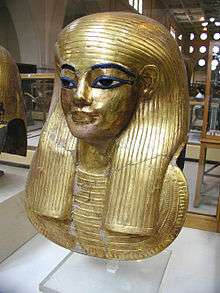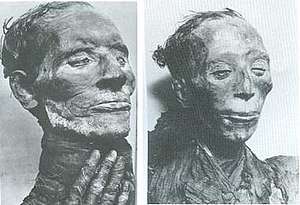Yuya
Yuya (sometimes Iouiya, also known as Yaa, Ya, Yiya, Yayi, Yu, Yuyu, Yaya, Yiay, Yia, and Yuy)[1] was a powerful Egyptian courtier during the Eighteenth dynasty of Egypt (circa 1390 BC). He was married to Tjuyu, an Egyptian noblewoman associated with the royal family, who held high offices in the governmental and religious hierarchies. Their daughter, Tiye, became the Great Royal Wife of Amenhotep III.[2]
| Yuya King’s Lieutenant Master of the Horse Father-of-the-god | |
|---|---|
 Gilded mummy mask of Yuya, now in the Cairo Museum | |
| Dynasty | 18th Dynasty |
| Pharaoh | Amenhotep III |
| Wife | Tjuyu |
| Children | Tiye, Anen, possibly Ay |
| Burial | KV46 |
| Yuya in hieroglyphs |
|---|
They also may have been the parents of Ay,[3] an Egyptian courtier active during the reign of pharaoh Akhenaten, who eventually became pharaoh, as Kheperkheprure Ay. There is no conclusive evidence, however, regarding the kinship of Yuya and Ay, although certainly, both men came from the town of Akhmim.[4] Yuya and Tjuyu also are known to have had a son named Anen, who carried the titles "Chancellor of Lower Egypt", "Second Prophet of Amun","sm-priest of Heliopolis, and "Divine Father".[5]
The tomb of Yuya and Tjuyu was, until the discovery of Tutankhamun's, one of the most spectacular ever found in the Valley of the Kings despite Yuya not even being a pharaoh. Although the burial site was robbed in antiquity, many objects not considered worth plundering by the robbers remained. Both the mummies were largely intact and were in an amazing state of preservation. Their faces in particular were relatively undistorted by the process of mummification, and provide an extraordinary insight into the actual appearance of the deceased while alive (see photographs).
Origins

Yuya came from the Upper Egyptian town of Akhmim, where he probably owned an estate and was a wealthy member of the town's local nobility. His origins remain unclear. The study of his mummy showed that Yuya had been a man of taller than average stature and the anatomist Grafton Elliot Smith considered that his appearance was not typically Egyptian.
Taking into account his unusual name and features, some Egyptologists believe that Yuya was of foreign origin, although this is far from certain.[6] The name Yuya may be spelled in a number of different ways as Gaston Maspero noted in Theodore Davis's 1907 book—The Tomb of Iouiya and Touiyou.[7] These include "iAy", ywiA", yw [reed-leaf with walking feet]A, ywiw" and, in orthography—normally a sign of something foreign—"y[man with hand to mouth]iA".[8]
The Biographical Dictionary of Ancient Egypt suggests that foreign origin. "it is conceivable that he had some Mitannian ancestry, since it is known that knowledge of horses and chariotry was introduced into Egypt from the northern lands and Yuya was the king's 'Master of the Horse'." It also discusses the possibility that Yuya was the brother of queen Mutemwiya, who was the mother of Pharaoh Amenhotep III and may have had Mitannian royal origins.[9] However, this hypothesis can not be substantiated, since nothing is known of Mutemwiya's background. While Yuya lived in Upper Egypt, an area that was predominantly native Egyptian, he could have been an assimilated descendant of Asiatic immigrants or slaves who rose to become a member of the local nobility at Akhmin. If he was not a foreigner, however, then Yuya would have been the native Egyptian whose daughter was married to Amenhotep III. Yuya is believed to have died around 1374 BC in his mid 50s.
Career
Yuya served as a key adviser for Amenhotep III,[3] and held posts such as "King’s Lieutenant" and "Master of the Horse"; his title "Father-of-the-god" possibly referred specifically to his being Amenhotep's father-in-law. In his native town of Akhmin, Yuya was a prophet of Min, the chief god of the area, and served as this deity's "Superintendent of Cattle".[10]
Tomb

Yuya and his wife were buried in the Valley of the Kings at Thebes, where their private KV46 tomb was discovered in 1905[11] by James Quibell, who was working on behalf of Theodore M. Davis. Although the tomb had been penetrated by tomb-robbers, perhaps they were disturbed as Quibell found most of the funerary goods and the two mummies virtually intact.[10] As the Egyptologist Cyril Aldred noted:
Though the tomb had been rifled in antiquity, the [tomb's] opulent funerary furniture was largely intact, and there was no doubt as to the identity of the pair, who were found resting among their torn linen wrappings, within their nests of coffins.[12]
The goods buried with Yuya and Tjuyu constituted probably the finest ensemble of high-class New Kingdom furniture, etc., recovered before the discovery of the tomb of Tutankhamun seventeen years later.
Proposed identification with biblical Joseph
Journalist Ahmed Osman in his book Stranger in the Valley of the Kings has suggested an identification between Joseph, the ancient Hebrew patriarch who led the tribe of Israel into Egypt during a famine, and Yuya. [13] This theory has not been accepted in mainstream Egyptology. Donald B. Redford wrote a scathing review of Stranger in the Valley of the Kings for Biblical Archaeology Review.[14] Similarly, Deborah Sweeney has expressed great doubt toward the proposed identification. Sweeney states that the title "God's father of the Lord of the Two Lands" is an extension of the title "God's Father," which is not exclusive to Yuya. The Bible claims that Joseph's mummified body was exhumed and transported to Canaan by the Israelites, while Yuya's remained undisturbed in the Valley of the Kings in Egypt, where his mummy was discovered in 1906.[15]
References
- Osman p. 113
- Rice, Michael (1999). Who's Who in Ancient Egypt. Routledge. p. 207.
- Rice, p.222
- David, Anthony & Rosalie, A Biographical Dictionary of Ancient Egypt, London: Seaby, 1992. p.167
- Rice, p.20
- David O'Connor & Eric Cline, Amenhotep: Perspectives on his Reign, University of Michigan, 1998, p.5
- O'Connor & Cline, p.5
- Maspero's analysis of Yuya's complex name is given on page xiii-xiv of The Tomb of Iouiya and Touiyou by Theodore M. Davis, Archibald Constable and Co. Ltd, 1907
- Anthony David & Rosalie David, A Biographical Dictionary of Ancient Egypt, London: Seaby, 1992, p.167 ISBN 1-85264-032-4
- David & David, p.167
- Cyril Aldred: Akhenaten, King of Egypt Thames and Hudson, 1989. p.96 ISBN 0-500-27621-8
- Aldred, p.96
- Osman, Ahmed Stranger in the Valley of the Kings, San Francisco: Harper & Row, (1987) ISBN 0-06-250674-9
- Redford, Donald B. Review of Stranger in the Valley of the Kings by Ahmed Osman. BAR 15/2 p.8
- Deborah Sweeney, Review: Osman, "Stranger in the Valley of the Kings", The Jewish Quarterly Review, New Series, Vol. 82, No. 3/4 (Jan. - Apr., 1992), pp. 575-579
External links
| Wikimedia Commons has media related to Yuya. |
- "Discussion and images of the mummies of Yuya and Tjuyu". Tripod homepage. Retrieved March 2, 2006.
- The Treasures of Yuya and Tuyu
- Who Was Joseph? The Mummy of the Patriarch Joseph in the Cairo Museum